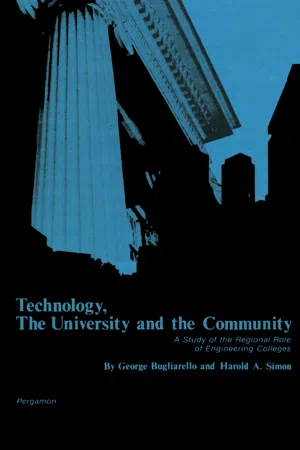Technology & Engineering
Engineering Institution
An engineering institution is an organization that promotes and supports the field of engineering through education, research, and professional development. These institutions often provide accreditation for engineering programs, offer resources for engineers, and contribute to the advancement of engineering knowledge and practices. They play a crucial role in shaping the future of the engineering profession.
Written by Perlego with AI-assistance
Related key terms
1 of 5
3 Key excerpts on "Engineering Institution"
- eBook - PDF
Technology, the University and the Community
A Study of the Regional Role of Engineering Colleges
- George Bugliarello, Harold A. Simon(Authors)
- 2013(Publication Date)
- Pergamon(Publisher)
*Hugh Folk and Betty M. Vetter, Report on Workshop IV—Technological Man-power Retraining: The Role of the Engineering College in Retraining Engineers as Technological Needs and Employment Patterns Shift, Appendix 11-15. The Engineering College and its Environment 9 2. the minimum requirements, which are greatly influenced by the standards set for entrance into advanced graduate programs. This has led to the common criticism that educators are more concerned with compressing additional new knowledge into the undergraduate pro-grams, than with developing a sensitivity to societal problems. 3. the individual student's developing view of his own interests and commitment. This has tended to generate programs with inherent flexibility permitting many options to the student. 4. the requirements of potential employers. Here the tendency has b e e n to p r e s e r v e traditionally accepted areas of study, such as Mechanical or Civil Engineering, even though this leads to duplication and awkwardness in the design of programs, as the boundaries be-tween many of these areas become blurred. 5. the guidelines set down by the various accrediting bodies. 6. the standards set for entry into the profession as typified by the Professional Engineering Licensing Examinations. It is largely through the u n d e r g r a d u a t e and graduate programs that students are developed as a h u m a n resource, able by their ac-quired knowledge and skill to use and generate information for the solution of problems in the real world. T h e current of criticism re-flected by J o h n s o n 7 points to what is seen as insufficient sensitivity to societal problems and the criteria which are realistic in that realm. It does appear that engineering students are best equipped to deal with the technological world, while the interface with societal issues is treated in a more haphazard fashion. - eBook - PDF
- Paul H. Wright(Author)
- 2012(Publication Date)
- Wiley(Publisher)
21 2.1 ENGINEERING The Accreditation Board for Engineering and Technology (ABET) defines engi- neering as “the profession in which a knowledge of the mathematical and nat- ural sciences gained by study, experience, and practice is applied with judgment to develop ways to utilize, economically, the materials and forces of nature for the benefit of mankind.” (1) Embodied in that definition are certain fundamental elements that describe the essence of engineering. Engineering is a profession. Like law, medicine, architecture, teaching, and the ministry, it aspires to high standards of conduct and recognizes responsibilities to clients, peers, and to society as a whole. It is based on a special body of knowledge, and its members attain professional sta- tus through well-defined avenues of education and training. Engineering is based on a knowledge of mathematical and natural sciences. Both the engineer and scientist are thoroughly educated in the mathe- matical and natural sciences, but the scientist primarily uses this knowl- edge to acquire new knowledge, whereas the engineer applies the knowledge to design and develop usable devices, structures and pro- cesses. In other words, the scientist seeks to know, the engineer aims to do. (2) In the words of Theodore von Kárman (3): “Scientists explore what is; engi- neers create what had not been.” Glegg (4) contrasted the function of scientists and engineers as follows: D E F I N I T I O N O F E N G I N E E R I N G C H A P T E R T W O It seems fashionable to glamorize the position of the scientist and to imply that no other occupation is so rewarding in human, if not material, values. I do not think that this is true for several reasons. For instance, the engineer has the much wider horizon of possibilities. A scientist is lucky if he makes one real creative addition to human knowledge in his whole life, and may never do so. An engineer has, by comparison, almost limitless opportunities. - eBook - PDF
Let there be Light
Engineering, Entrepreneurship and Electricity in Colonial Bengal, 1880–1945
- Suvobrata Sarkar(Author)
- 2020(Publication Date)
- Cambridge University Press(Publisher)
Technical Knowledge and Its Institutions | 33 1904, when the Indian Universities Act was passed that permitted post-graduate teaching and research in the humanities and the sciences. 18 What impact did it have on contemporary engineering education? Taking stock of the much-diversified system of instruction, length of the courses, and nomenclature adopted by the various engineering colleges, the Act asked for uniformity in the system and stated that further provision was needed for instruction in mining and electrical engineering. 19 These recommendations were hotly debated in the official circle. Spring was of the opinion that excellence in engineering depended chiefly upon racial and personal qualifications of the candidate, and next upon the quality of teaching in the colleges, and these had better be dissociated from the universities altogether. He further recommended that ‘the universities should leave on one side practical engineering, and should only test the men’s knowledge of scientific principles, while the college authorities should test practical ability’. 20 H. W. Orange, another official, thought that a technical institution should either be independent, like a higher polytechnic, and should grant its own degrees, or that it should be an organic part of a teaching university, instances of which were the Massachusetts Institute of Technology at Boston and the German polytechnics. He ridiculed the idea of an institution for master’s in civil engineering, considering that in the previous 50 years no candidate had ever attained a master’s degree in Calcutta. At that time there were three engineering degrees, namely the licentiate, the bachelor’s, and the master’s. 21 One R. Nathan remarked: It is doubtful whether the universities have done, much to foster or improve the study of engineering.
Index pages curate the most relevant extracts from our library of academic textbooks. They’ve been created using an in-house natural language model (NLM), each adding context and meaning to key research topics.


